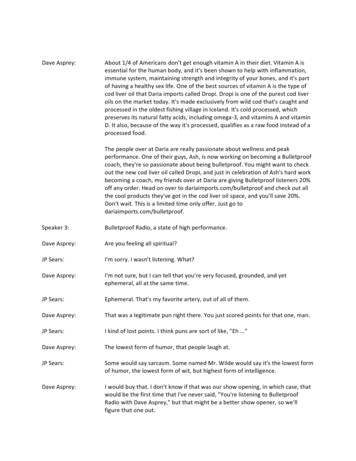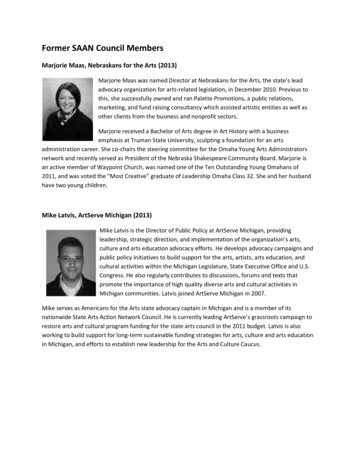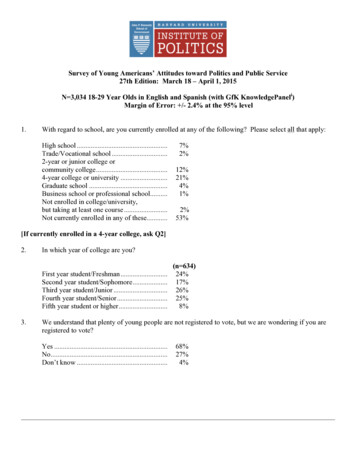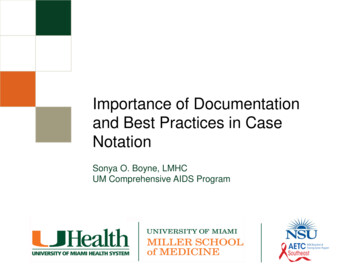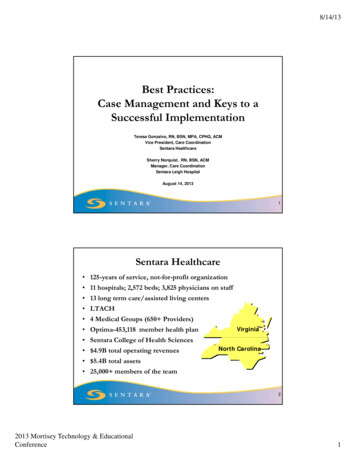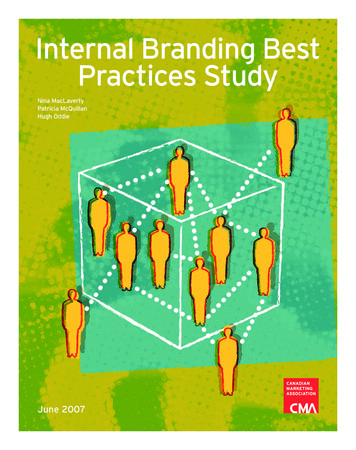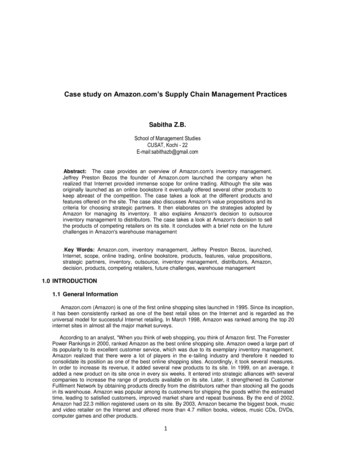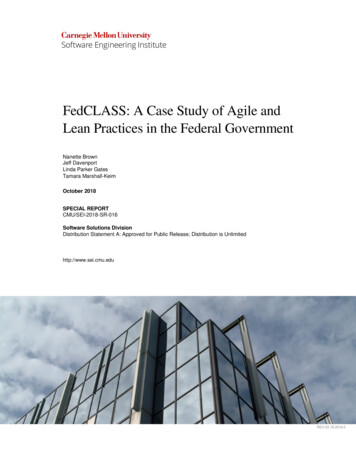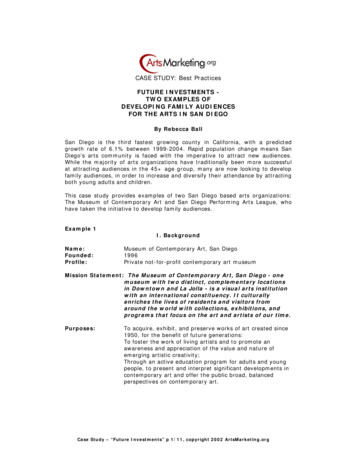
Transcription
CASE STUDY: Best PracticesFUTURE INVESTMENTS TWO EXAMPLES OFDEVELOPING FAMILY AUDIENCESFOR THE ARTS IN SAN DIEGOBy Rebecca BallSan Diego is the third fastest growing county in California, with a predictedgrowth rate of 6.1% between 1999-2004. Rapid population change means SanDiego’s arts community is faced with the imperative to attract new audiences.While the majority of arts organizations have traditionally been more successfulat attracting audiences in the 45 age group, many are now looking to developfamily audiences, in order to increase and diversify their attendance by attractingboth young adults and children.This case study provides examples of two San Diego based arts organizations:The Museum of Contemporary Art and San Diego Performing Arts League, whohave taken the initiative to develop family audiences.Example 1Name:Founded:Profile:I. BackgroundMuseum of Contemporary Art, San Diego1996Private not-for-profit contemporary art museumMission Statement: The Museum of Contemporary Art, San Diego - onemuseum with two distinct, complementary locationsin Downtown and La Jolla - is a visual arts institutionwith an international constituency. It culturallyenriches the lives of residents and visitors fromaround the world with collections, exhibitions, andprograms that focus on the art and artists of our time.Purposes:To acquire, exhibit, and preserve works of art created since1950, for the benefit of future generations:To foster the work of living artists and to promote anawareness and appreciation of the value and nature ofemerging artistic creativity;Through an active education program for adults and youngpeople, to present and interpret significant developments incontemporary art and offer the public broad, balancedperspectives on contemporary art.Case Study – “Future Investments” p 1/11, copyright 2002 ArtsMarketing.org
II. Project Description“Free For All Family Sundays” - Free admission and family-targetedactivities at the two locations of the Museum of Contemporary Art, SanDiego (MCA).The MCA’s “Free For All Family Sundays” were launched in July 1996, financed bya four-year grant from the Pew Charitable Trust and the Lila Wallace Reader’sDigest Fund. The program enables the museum to open for free on the firstSunday of every month. Family tours, workshops and activities are programmedwhich focus on particular works or artists. Families are encouraged to exploreparticular concepts, genres and ideas together. The days are marketed as familyevents (as opposed to children’s events) with advertisements in the local familypress and a postcard inviting parents to “build on their child’s imagination”.III. Strategy and ImplementationThe majority of the members and visitors to the Museum of Contemporary Art,San Diego (MCA) represent a narrow social group. As is true of many museums,this social group is middle-aged, affluent, and highly educated. Aware that it wasonly reaching a very small segment of its potential audience, the Museum decidedto target younger adults (ages 25-45) to broaden its current audience, and togenerate future audiences and members for the museum.By targeting this age group the MCA had to address two key issues:1. The majority of people in this age group work full-time, therefore, theirleisure time is limited to evenings and weekends.2. Many people in this age group have young children; therefore, they arelooking for leisure activities that they can participate in as a family.In order to attract the 25-45 age group, the MCA decided that it was importantto make the Museum “family-friendly” and to market it as a place where familiescan participate in engaging, high quality weekend activities together. For “FreeFor All Family Sundays”, the Museum planned activities that adults and childrencould participate in together including “hands-on family art projects” and “familyart tours.” By marketing this event to “the family” the MCA not only attractedpeople in the targeted 25-45 age group, it also increased access andopportunities for children to visit the galleries, encouraging a new generation ofart audiences. By marketing to families, the MCA sought to develop potentialaudiences and future members both in the short-term and in the long-term.The MCA relied on print media to promote ““Free For All Family Sundays””. TheMuseum ran one monthly ad in the San Diego Family Magazine, which cost 400;however, this is the only money allocated to marketing in the overall projectbudget. The Museum also produced rack cards that are distributed at both MCAlocations (downtown San Diego and La Jolla), as well as at various rack cardlocations throughout San Diego, visitor centers and hotels The distributionsystem may expand to include the local library system and area YMCAs. TheMuseum also depends on free listings in various newspapers and localpublications and articles generated through its Public Relations efforts.Case Study – “Future Investments” p 2/11, copyright 2002 ArtsMarketing.org
III. ResultsThe number of people attending the “Free For All Family Sundays” is a measureof the program’s success.oOver 1,000 people visited the MCA/La Jolla on Sunday, November 4,2001.oVisitor surveys have shown that people travel from all over San Diegofor “Free For All Family Sundays”. Many families attend several times ayear; some attend every month.oThe quality of the experience has been captured through visitorinterviews that describe the vivid memories of participants in the FreeFor All programs.The MCA feels that the “Free For All Family Sundays” are training people to befuture arts goers; in this respect, the program has had a positive impact not onlyon the Museum’s future audiences, but also on all of San Diego’s arts audiences.IV. ConclusionMore than just a series of events, the MCA’s “Free For All Family Sundays”support goals of sustainable audience development and showcase an attempt tochange the relationship between the community and the Museum. By providingan enjoyable shared experience through “Free For All Family Sundays”, the MCAhopes that Museum visits will become part of each family’s collective memory andthat attending museums or engaging with artworks would become an activity thatboth children and adults enjoy.While the “Free for All” program has not resulted in an immediate increase inmembership among those families who attend the days, these families do not payto visit the museum at other times during the month. The outcomes of theprogram have led MCA staff to re-evaluate their initial objectives and toconclude that even if the project does not result in a short-term increase inmembership its popularity will inevitably build good will, engagement andcommunity currency among people who, in turn, will become advocates, visitorsand possibly members of MCA in the future. “Free For All Family Sundays”demonstrate that effective audience development is a long-terminvestment that demands sustained engagement in the local community.Case Study – “Future Investments” p 3/11, copyright 2002 ArtsMarketing.org
Example 2Name:Founded:Profile:I. BackgroundSan Diego Performing Arts League1986San Diego Performing Arts League is a not for profit artsmembership organizationMission Statement: The San Diego Performing Arts League seeks topromote and advance the performing arts in SanDiego County. The League is dedicated to developingcost effective collaborative programs that bring newaudiences to the arts and strengthen San Diego’sperforming arts with new sources of earned incomeand management support. It serves as an effectiveand proactive advocate for the County’s performingarts.II. Project DescriptionSan Diego Performing Arts League developed “Family Theatre Days” to: Make live theatre more accessible to families from all social groupsSubsidize the first experience of live performance for many children“Family Theatre Days” “Kids Go Free” coupons introduce families to thePerforming arts and help bring a new generation to the theatre. TheatreTicket prices can be restrictive to many families, in particular larger families orFamilies with limited incomes.This high profile program also supports San Diego Performing Arts League’sprimary objective to promote and advance the performing arts in San Diego byraising the visibility of the arts and building new arts audiences.III. Strategy and ImplementationThe “Family Theatre Days” program was launched in 1991. The program offersfree theatre tickets for children when an accompanying adult purchases a fullpriced ticket. The tickets are donated by participating theatres; each theatrerespectively specifies the performance, quantity of tickets and particular days thatare available. In return for their participation, the theatres benefit from exposureas part of a high profile marketing and publicity campaign includingadvertisements in the San Diego Union-Tribune and local family press, radio andcable TV coverage, media interviews and Web site publicity. The program isfunded by sponsorship from Target Stores, Time-Warner Cable and SempraEnergy. These sponsors have been involved with “Family Theatre Days” over the11 years of the program’s existence. In return for funding the sponsors promotedgoodwill/and gained recognition for “giving back” to the community. Themotivation for these corporations to sponsor the program included an interest inthe target market for “Family Theatre Days” (families) and opportunities to enrichlives through the arts (by introducing children to what could potentially be a lifelong relationship with the performing arts.)While “Family Theatre Days” is a well-established program and its main objectiveshave remained the same since the onset of the program, the framework has beenCase Study – “Future Investments” p 4/11, copyright 2002 ArtsMarketing.org
adapted to ensure its continuing effectiveness and relevance. In 1999, San DiegoPerforming Arts League decided that the life span of the project should beshortened from a fall program to a holiday season program. This succeeded ingenerating a sense of urgency around the program and also meant that it couldcapitalize on winter vacation—when families have more leisure time and are morelikely to take advantage of the “Family Theatre Days” program. The San DiegoPerforming Arts League has also worked to ensure that families can easily get the“Kids Go Free” coupons through several channels: Flyers distributed in Target Stores, schools, and participating venues Newspaper advertisements - The tag line was a take-off of the League’sregular tagline: Instead of MUSIC DANCE THEATRE LIFE, the ads readMUSIC DANCE THEATRE KIDS. Each ad included information on each ofthe participating shows. The Internet – The online coupon was created as a PDF file and wasdownloadable and printable. Information about the program was on theLeague’s Web site and on the Target Web site. League Arts members wereencouraged to link to both of those sites, but didn’t track how manyactually did so.The program demonstrates that the widespread availability of coupons isa crucial factor in the number of people taking advantage of the program.With the addition of the slogan Music Dance Theatre KIDS, the marketing of the“Family Theatre Days” program has been brought in line with the overallbranding of the San Diego Performing Arts League, simultaneously increasingthe impact of the message and reinforcing the identity of the San DiegoPerforming Arts League.The program sponsors drove the choices for promotion. Flyers weremainly distributed at Target Stores, which reached the target market of familieswith young children. Wider distribution might have helped the program reachmore audiences.IV. ResultsThe number of participants has demonstrated the program’soverwhelming success. In the year 2000, “Kids Go Free” tickets were offeredfor 144 performances in San Diego. Over 1100 children and adults participated inthe program and 14,915 was generated in revenue from the sale of the adulttickets for participating arts organizations.It is difficult, however, to fully assess the outcome of the program. No preliminarymarket research was done to reach a target customer. It has been a challenge totrack audiences to assess what demographic groups are being reached or to see iffamilies re-attend theatre performances at times other than “Family TheatreDays”.Tracking audiences and putting audience information into databases foreasy reference will be vital for the long-term success of “Family TheatreDays”.Without the hard data that tracking provides, San Diego’s artscommunity will not be able to fully capitalize on the impact of the program. SanDiego Performing Arts League now encourages the tracking of data byparticipating arts groups; it develops agreements with all participating venuesthat outline each theatre’s responsibility to track its audiences.Case Study – “Future Investments” p 5/11, copyright 2002 ArtsMarketing.org
V. ConclusionIn recent years much has been written on the potential positive impacts of thearts on children and young people. It is widely agreed that while an art exhibition,theatre production or dance performance can be enriching, enjoyable andilluminating for audiences of all ages, for children, in particular, there a wealth ofadditional positive effects; including developing creativity, communication andproblem solving skills. The Champions of Change: The Impact of the Arts onLearning Research1 (President's Committee on the Arts and the Humanities/ArtsEducation Partnership, 1999) demonstrated that young people with high levels ofparticipation in the arts are often high academic achievers with the positiveimpact of the arts on learning evident across the whole curriculum. It is alsoargued that the arts are often able to engage and challenge young people whofeel excluded and unmotivated within traditional education contexts.In California, the decrease in the amount of arts provision in many schools meansthat it is becoming increasingly vital that arts organizations reach out to youngeraudiences, not only to guarantee that children do not miss out on the valuableexperiences of the arts but also to ensure that the organisations themselves haveaudiences in the future. After all, it has been widely argued that people whoattend the arts as children are more likely to attend the arts as adults.(1 Available for free download as a PDF document at the following URL. Note - Youmust have Adobe Acrobat 5 to read this ort.pdf)ABOUT THE WRITER - Rebecca Ball joined the San Diego Performing Arts Leagueas an intern from October 2001 to January 2002, when she returned to hernative England to take up an arts administration position. She has an MA inEuropean Cultural Policy & Administration and has worked for a number of yearsfor umbrella arts organizations in the UK, most recently helping the West SussexDance Partnership to develop a strategy for the development of dance in theregion.VI. Relevant ureFigureFigureFigure1 – Ad – Free for All Sundays, San Diego Family Magazine, April 2002.2 – Event photograph from Free for All Family Sundays, MCA San Diego.3 – Event photograph from Free for All Family Sundays, MCA San Diego.4 – Event photograph from Free for All Family Sundays, MCA San Diego.5 - Event photograph from Family Theatre Days.6 – Event photograph from Family Theatre Days.7 – (left) Rack Card8 – (right) Ad in The San Diego Union-Tribune, October 21, 20019– “Kids Go Free” coupons10– Family Theatre Days brochureCase Study – “Future Investments” p 6/11, copyright 2002 ArtsMarketing.org
Figure 1.Ad – Free for All Sundays, San Diego Family Magazine, April 2002.Figure 2.Photograph from Free for All Family Sundays, MCA San Diego.Case Study – “Future Investments” p 7/11, copyright 2002 ArtsMarketing.org
Figures 3 and 4 - Photographs from Free for All Family Sundays, MCA San Diego.Case Study – “Future Investments” p 8/11, copyright 2002 ArtsMarketing.org
Figures 2 and 3.Event photographs from Family Theatre Days.Case Study – “Future Investments” p 9/11, copyright 2002 ArtsMarketing.org
Figure 4. (left ) Rack Card (actual size: 9.25 in. x4 in.) Figure 5. (right) Ad in TheSan Diego Union-Tribune, October 21, 2001 (actual size 10 in. x 7.5 in)Case Study – “Future Investments” p 10/11, copyright 2002 ArtsMarketing.org
Figure 6. “Kids Go Free” coupons (actual size: 12 in. x 9 in, folded in thirds as one side ofbrochure – Figure 7. below)Case Study – “Future Investments” p 11/11, copyright 2002 ArtsMarketing.org
press and a postcard inviting parents to “build on their child’s imagination”. III. Strategy and Implementation The majority of the members and visitors to the Museum of Contemporary Art, San Diego (MCA) represent a narrow social group. As is true of many museums, this so

